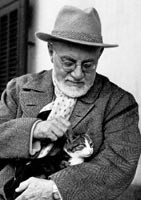
 Henri Émile Benoît Matisse, considered the leader of the Fauvist movement, was born 31 December 1869, in his maternal grandparents home at Cateau-Cambresis, Nord-Pas-de-Calais, France to a family of Flemish origin. His childhood was spent ten miles away in Bohain-en-Vermandois, near the Belgian border, and his father, Émile Hippolyte Matisse, was a grain merchant whose family were weavers. His mother, Anna Heloise Gerard, was a daughter of a long line of well-to-do tanners. Matisse's parents were the owners of a general store selling household goods and seeds.
Henri Émile Benoît Matisse, considered the leader of the Fauvist movement, was born 31 December 1869, in his maternal grandparents home at Cateau-Cambresis, Nord-Pas-de-Calais, France to a family of Flemish origin. His childhood was spent ten miles away in Bohain-en-Vermandois, near the Belgian border, and his father, Émile Hippolyte Matisse, was a grain merchant whose family were weavers. His mother, Anna Heloise Gerard, was a daughter of a long line of well-to-do tanners. Matisse's parents were the owners of a general store selling household goods and seeds.
The artist himself later said he got his color sense from his mother, who was herself an accomplished painter on porcelain, a fashionable art form at the time. After the war of 1870-71 his family returned to Bohain-en-Vermandois.
As a young man, he went to Paris to study law, and graduated In 1889 while working as a clerk for an attorney in Saint-Quentin, he took courses in textile and tapestry design at the Quentin de La Tour school. He returned home to work as a clerk in a law office working as a court administrator in Le Cateau-Cambrésis after gaining his qualification. It was at this time that he had an acute attack of appendicitis in 1890, requiring surgery and a nearly year long period of convalescence. At this time he became intrigued by the practice of painting. His mother gave him a paint box, and at the age of 21, and Matisse began painting during his time of convalescing in the hospital, and art for him became "a kind of paradise" as he later described it, adding that, “From the moment I held the box of colors in my hands, I knew this was my life. His first two canvases, from 1890, are essentially consummate Old Master-ish still-lifes. Soon he was decorating the home of his grandparents at Le Cateau.
He began by painting still-lifes and landscapes in the traditional Flemish style. He decided to become an artist, deeply disappointing his father. He decided to abandon law, and take up art studies. He studied at the École des Beaux-Arts, until 1897, and began by exhibiting 5 paintings in the salon of the Société Nationale des Beaux-Arts, and the state bought two of his paintings, while he was an art student.
Matisse copied paintings in the Louvre and painted outdoors in Paris. From 1898, under the influence of impressionism, Matisse's palette became lighter, as in his seascapes of Belle-Île and landscapes of Corsica and the Côte d'Azur.
The painting Harmony In Red, on the right with it's red walls and tablecloth, and interweaving pattern of blue, is one of Mattise's most unusual color creations, with a history just as fascinating and complex. The canvas began its life as Harmony in Green, and was then transformed to Harmony in Blue. It then was bought by Sergei Shchukin, who honored Matisse's request to work on it one last time, with this Masterpiece as the final result. The fact Matisse was painting on a predominantly blue ground rather than on a fresh white canvas very likely influenced his choice of this particular red.

 In January of 1898 Henri Matisse married a young woman from Toulouse, Amelie Noemie Alexandrine Parayre. The family was supported through the sale of all the painter's still lifes to a dealer who paid 400 francs apiece for them. A daughter, Marguerite was born in 1894. After two sons, Jean (born 1899) and Pierre (born 1900) were born, Amelie turned to millinery to augment the family income and opened her own shop. Her love of Oriental patterned fabrics is depicted in her husband's portraits of her in a Japanese kimono.
In January of 1898 Henri Matisse married a young woman from Toulouse, Amelie Noemie Alexandrine Parayre. The family was supported through the sale of all the painter's still lifes to a dealer who paid 400 francs apiece for them. A daughter, Marguerite was born in 1894. After two sons, Jean (born 1899) and Pierre (born 1900) were born, Amelie turned to millinery to augment the family income and opened her own shop. Her love of Oriental patterned fabrics is depicted in her husband's portraits of her in a Japanese kimono.
From 1900 Matisse suffered great material hardship for years. Due to illnesses suffered by Amelie and then by Matisse himself, the family was forced to move in with his parents. In 1902 the artist, his wife Amélie, and their three children were forced to return to Bohain. He spent the summer of 1905 at Collioure, a small French fishing port on the Mediterranean, near the Spanish border. Between 1908 and 1913 Matisse made journeys to Spain, Germany, Russia, and Africa. In Munich, Germany, he saw an exhibition of Islamic art (1910), and in Moscow, Russia, he studied Russian icons (1911). Russian collectors began to buy his paintings. In 1929, Matisse temporarily stopped painting easel pictures.
During the Second World War Matisse lived in the south of France – Bordeaux, Ciboure, Nice. After the end of the war that Matisse turned anew to monumental compositions. At the age of 77, Matisse began the greatest project of his life and spent more than 4 years working on the chapel, its architecture, its stained glass windows, its interior furnishings, its murals, and the vestments of the priests at Chapelle du Rosaire de Vence at Vence, France, a Riviera hill town where Matisse had a villa from 1943 to 1948. Matisse designed three great murals to be made by painting on white tiles with black paint and then firing the large sections of tile. Each tile measures 12 in.2. Matisse was so crippled with ailments by this time that he could only work from a wheelchair, and he had a long stick with a brush strapped to his arm and pieces of construction paper placed on the wall. He then drew the images, which were transferred to tiles by skilled craftsmen. Saint Paul de Vence remains a favorite location for artists in France. Romans occupied the region around 120BC.
In 1537 King François I expanded the fortifications of the village, which was right on the border of his empire. Looking at this very French city called Nice today we tend to forget that the County of Nice was ceded to the French Empire only in 1860 by a treaty between the House of Savoy-Sardinia (the future Italian kings) and Napoleon III as a reward for French assistance in the Second Italian War of Independence against Austria. Until the mid 17th century Saint Paul prospered. It was elevated to the coveted rank of "Ville Royale", a town under direct control of the French king. But in 1747, with the wars of succession, disaster struck when the town was invaded and many buildings were destroyed. While most of the houses were rebuilt, Saint Paul's importance gradually declined as the towns on the coastal plains developed in the 19th and 20th century the town on the rock above was largely forgotten. In retrospect this turned out to be a good thing as its architectural heritage remained untouched. In the 1920's artists discovered romantic Saint Paul. From then on prudent planning and conservation efforts made Saint Paul to one of the most coveted destinations on the Côte d'Azur. Dating back 400 years, it's charm can be observed in it's cobbled alleys, covered archways, hidden squares with fountains and the multi-storey stone houses leaning against each other.
 His work on the chapel was completed in 1951, and Matisse declared it his masterpiece. In 1917 Matisse moved to southern France and settled in Nice. Matisse designed for the ballet (1920, 1938) From the 1920s until his death, Matisse spent much time in the south of France, particularly Nice. He and his wife of 41 years separated in 1939. In 1941 he was diagnosed with cancer and, following surgery, he started using a wheelchair. Confined to bed following the surgury, he turned his attention to book design and illustrations. Friends tried to persuade the aging artist to leave France, but Matisse said, "If all the talented people left France, the country would be much poorer.
His work on the chapel was completed in 1951, and Matisse declared it his masterpiece. In 1917 Matisse moved to southern France and settled in Nice. Matisse designed for the ballet (1920, 1938) From the 1920s until his death, Matisse spent much time in the south of France, particularly Nice. He and his wife of 41 years separated in 1939. In 1941 he was diagnosed with cancer and, following surgery, he started using a wheelchair. Confined to bed following the surgury, he turned his attention to book design and illustrations. Friends tried to persuade the aging artist to leave France, but Matisse said, "If all the talented people left France, the country would be much poorer.
After 1950 he suffered from asthma and heart trouble. Matisse died in 1954 at Vence, in the south of France, after suffering a heart attack at his apartment in Nice on 3 November 1954 at the age of 84, and was buried in the cemetery of the Monastère Notre Dame de Cimiez, near Nice. He left a letter, to be delivered after his death, making peace with Amélie.

 Fallen Tabernacle of David In The Arts
Fallen Tabernacle of David In The Arts
 Rembrandt Van Rijn
Rembrandt Van Rijn
 Leonardo da Vinci
Leonardo da Vinci
 Claude Monet
Claude Monet
 Pierre Auguste Renoir
Pierre Auguste Renoir
 Johannes Vermeer
Johannes Vermeer
 The Artist As Prophet
The Artist As Prophet
 Henri Émile Benoît Matisse
Henri Émile Benoît Matisse
 Paint By The Spirit: Paint By The Spirit: The Religious Art of Vincent Van Gogh
Paint By The Spirit: Paint By The Spirit: The Religious Art of Vincent Van Gogh